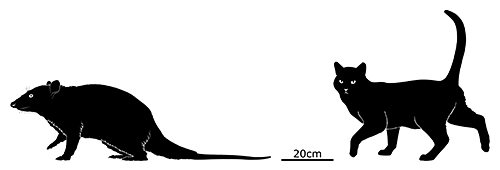The Pontide island 43 million years ago had no placental mammalian carnivores, and in their absence a different type of mammal took up the main predatory niches – the metatherians.
Metatherians today are represented solely by marsupials, but there were once many other branches of this mammal lineage. One group present in Europe for much of the Cenozoic were the herpetotheriids, and these rat-sized animals seem to have also occupied the small predator and opportunistic omnivore niches on the Pontide island.
And then there were the bigger metatherians.
Anatoliadelphys was a specialized carnivore, with strong jaws and bone-crushing teeth similar to the modern Tasmanian devil. It had a body size similar to a domestic cat, giving it a total length of up to 1m long (3′3″), and had opossum-like grasping digits and a prehensile tail indicating it was capable of climbing trees.
It was initially thought to be descended from another type of metatherian found in Europe at the time, the peradectids, but a later study came up with a more surprising result for its evolutionary relationships. It instead may be closer related to the polydolopimorphs, a group known mainly from South America. Quite how its ancestors got as far as Turkey is a bit of a mystery, but it’s possible they’d previously dispersed into Africa at a time when the continents were still much closer to each other than they are today, and then spread northwards until they reached the Pontide island.
The main problem with this hypothesis is the current lack of any polydolopimorphans in the African fossil record – but the African Eocene is still poorly understood, so there may be some metatherian fossils yet to be discovered that could fill in this gap.


